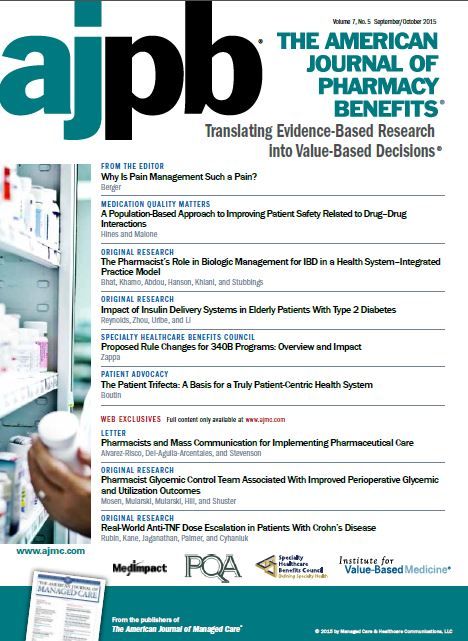Publication
Article
AJPB® Translating Evidence-Based Research Into Value-Based Decisions®
Web Exclusive: Pharmacists and Mass Communication for Implementing Pharmaceutical Care
Pharmacists' communication activities are critical to improving and maintaining a positive image among the public; therefore, a media plan should be in place in order to reach both broad and narrowly defined audiences.
ABSTRACT
One of the most important responsibilities of pharmacists practicing in a team-based environment is to stay current with news about health (ie, professional services, medicines, and important occasions such as World Pharmacists Day and National Pharmacist Day). Additionally, providing information to the media that highlights the positive outcomes of pharmacist care would help to improve or maintain a positive image among the public. For example, World Diabetes Day and World HIV/AIDS Day both present good opportunities to promote awareness of each disease, as well as disseminate information and highlight the role of pharmacists in care management for these patients. In this article, the authors share their experiences with, and suggestions for, effective communication with the media.
Am J Pharm Benefits. 2015;7(3):e125-e126
Communication activities are critical tools for the pharmaceutical profession in order to improve and maintain a positive image among the public. These important outreach efforts should be well-planned in order to successfully reach both a broad and narrowly defined audience. In order to allow more people to follow updates on and become aware of the patient care that is provided by pharmacists, it is important that the media also participate in these types of health-related events and provide details about their findings for the public.
Pharmacists Day Celebrations
Throughout the year, each region or country has a day, week, or even month to celebrate the contributions and work of pharmacists. These celebratory events present an ideal opportunity to communicate to patients and everyday citizens that pharmacists care about them and about the safe and effective use of medicines overall. Some examples of countries with national pharmacist celebrations include Turkey (May 14), Perú (May 13), and Canada (first week of March). In the United States, there is a national pharmacy month recognized by the American Pharmacists Association in October, as well as a national pharmacy week during that month recognized by the American Society of Health-System Pharmacists. Since 2010—the year of the first celebration of World Pharmacists Day (recognized by the International Pharmaceutical Federation)—the meaningful impact of pharmacists has been communicated and publicized around the world.
Experience With the Media: Medicine Regulatory Agency in Perú
By the 18th anniversary of the creation of the institutional pharmacy of the Medicine Regulatory Agency of the Ministry of Health in Perú, a pharmaceutical care campaign was designed and implemented in 2012. This campaign was tasked to develop 3 activities: 1) provide a drug information sheet using a lectern, 2) measure blood pressure, and 3) follow patient pharmacotherapy. Media reporters were invited to interview patients and record videos for TV news.
During the 5 days of the campaign, 815 people received the information sheets provided by the lectern. Blood pressure was also measured in 96 individuals: 62.5% were male and the average age among all participants was 67.83 years (SD = 13,624); results showed 25% of patients had blood pressure values ​​above the therapeutic target. In this group of patients, the pharmacotherapy assessment resulted in a total of 33 actual drug-related problems, with 12 adverse drug reactions.1 Broadcasting these outcomes via television helps to publicize the impact of pharmacists, and subsequently, this helps to improve pharmacists’ reputation and enhance pharmaceutical care services for the population.
Promoting the Role of the Pharmacist
As a profession, we should begin to track our progress and activity in the promotion of pharmacists and appropriate use of medicines to the public.2 By creating an inventory of these events, we can review trends and benchmark our progress. However, pharmacists do not need to limit themselves to just during regional/national celebrations for opportunities to communicate important messages to patients and to demonstrate how pharmacists can help them improve their use of medications and their health. For example, in 2011, the Director General of Medicines, Raw Materials, and Drugs (DIGEMID)3—the Medicine Regulatory Agency in Perú—issued a press release4 showing the correct use of asthma inhalers, with the media agency Andina5 going to visit the DIGEMID to interview the pharmacy team there.
Nevertheless, for pharmacists contemplating an event, one suggestion is to start at least 1 month before to prepare materials such as brochures or booklets for distribution to other pharmacists and healthcare institutions in their countries. A short guide outlining prospective communications with the media can be useful in promoting better organization for the media plan (Figure); this level of preparation will also help to streamline the message of the positive outcomes from pharmacist care. For example, on World Diabetes Day or for World HIV/AIDS day, there could be distribution of key articles and papers describing the role of pharmacists in caring for patients with these diseases.6
In summary, it is very useful to develop a mass communication plan and use a pharmacy network to share strategies, experiences, and plans for improving pharmacists’ roles as communicators and the public’s perception of this profession.
Author Affiliations: South American Network of Pharmaceutical Care (AA-R, SDA-A), Lima, Perú; University of Michigan Health System and College of Pharmacy (JGS), University of Michigan, Ann Arbor, MI.
Funding Source: None.
Author Disclosures: The authors report no relationship or financial interest with any entity that would pose a conflict of interest with the subject matter of this article.
Authorship Information: Concept and design (SDA-A, JGS); acquisition of data (AA-R, SDA-A); analysis and interpretation of data (AA-R); drafting of the manuscript (AA-R, SDA-A, JGS); critical revision of the manuscript for important intellectual content (AA-R, SDA-A, JGS); statistical analysis (AA-R); administrative, technical, or logistic support (AA-R; JGS).
Send correspondence to: Aldo Alvarez-Risco, MSc, Mg, Loma de los Pensamientos Mz C Lote 14 Dpto 401 Postal Code Lima 33. E-mail: [email protected].
REFERENCES
- Álvarez-Risco A, Zegarra Arellano E, Matos Valerio E, Mejía Acosta N, Solis Tarazona Z. Campaign pharmaceutical care as a strategy for implementation of pharmaceutical services: experience of Perú [Spanish]. Pharm Care Esp. 2013;15(1):35-37.
- Berger JE. The world has changed: medications matter. Am J Pharm Benefits. 2014;6(1):12.
- Director General of Medicines, Raw Material, and Drugs (DIGEMID) website [Spanish]. http://www.digemid.minsa.gob.pe. Accessed August 23, 2012.
- Three out of four asthmatic used incorrectly asthma inhalers [Spanish]. Agencia Peruana de Noticias (ANDINA) website. http://www.andina.com.pe/Espanol/noticia-tres-cada-cuatro-asmaticos-usan-forma-incorrecta-inhaladores-contra-asma-379147.aspx. Published September 23, 2011. Accessed August 23, 2012.
- Peruvian Agency of News (ANDINA) website [Spanish]. http://www.andina.com.pe. Accessed August 23, 2012.
- Kibicho J, Owczarzak J. A patient-centered pharmacy services model of HIV patient care in community pharmacy settings: a theoretical and empirical framework. AIDS Patient Care STDS. 2012;26(1):20-28

Newsletter
Stay informed on drug updates, treatment guidelines, and pharmacy practice trends—subscribe to Pharmacy Times for weekly clinical insights.






